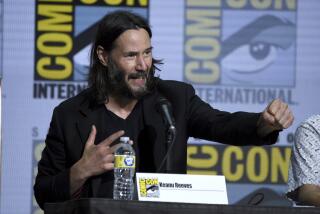Book review: ‘West of Here’ by Jonathan Evison
West of Here
A Novel
Jonathan Evison
Algonquin Books of Chapel Hill: 486 pp., $24.95
The trailing end of Manifest Destiny curls back on itself in “West of Here,” Jonathan Evison’s ambitious novel of the Pacific Northwest. Set dually in 1890 and 2006, the kaleidoscopic story follows those hoping to build their legacies in the wilds of Washington state’s Olympic Peninsula.
The fictional town of Port Bonita — a stand-in for Port Angeles — is at the center of the story. That’s where Ethan Thornburgh lands in the last days of 1889, a young man with big ideas and a moth-eaten suit, hoping to prove to his onetime girlfriend, Eva Lambert, that he can make something of himself. Eva, pregnant with Ethan’s child, is a proto-suffragette from a wealthy family, trying to help a struggling utopian colony come alive.
That’s on one side of town. Along the main street, there’s a bar with a mean owner and a whorehouse upstairs. There are two Native American settlements — one that’s Christian and keeps to itself, another that’s spread along the beach and struggling with alcohol.
Enter James Mather, a rugged explorer who captures Eva’s attention: He’s leading an expedition across the unmapped, spiny mountains toward Mt. Olympus. There are Native American legends: of the terrible destructive Thunderbird, of a beautiful green valley that is a safe haven nestled high in the mountains. That this path will take them south, instead of west, reflects how scarce the options were for a man hoping to make his name by conquering new territory.
As Mather and his expedition set out at the beginning of winter, Ethan — inspired by the sweep of the Elwha River, the high cliffs and a vision of the future — comes up with a plan to build a great dam, an industrial vision that is of its moment. Ethan imagines filling the valley with electricity and creating a metropolis to rival Seattle.
From the vantage point of 2006, Ethan’s vision doesn’t look quite so romantic. Port Bonita is an undistinguished town with a Wal-Mart and some bars, where the hard-won electricity does no more than keep KFC signs alight.
Here, the story moves among those connected by the last fish-packing plant in Port Bonita; it’s owned by Jared Thornburgh, scion of the town’s best-known family, who feels he doesn’t measure up. His second-in-command, Krig, a former high school sports star, has reached middle age and is Bigfoot-obsessed, single and drives an outdated car he calls the Goat. An ex-con, Timmon Tillman, works at the plant briefly before blowing his parole and heading for the mountains with vague ideas of making a life far from everyone. Another staffer, Rita, a Native American who dates a string of lousy ex-cons, is trying to reach her increasingly distant teenage son, Curtis, who has a doppelgänger in the past, a Native American boy with blue eyes, who is afflicted — with epilepsy, maybe, or maybe something more surreal.
Curtis and his 1890 counterpart are one of the book’s most direct parallels: They are close in age and similar in their disconnectedness from the world around them, showing that when it comes to the isolation of a teenage boy, the centuries make little difference. Yet that difference is highlighted by the paths taken by Mather and his crew, starving and hiking through hip-deep snow, and Tillman, following in his footsteps, littering a well-trod path with Snickers wrappers.
The novel takes on an epic historical shape yet remains light-footed, partly because Evison keeps each chapter short and also due to a straightforwardness, a narrative certainty passed through the characters, as in this passage when Eva foresees Ethan’s destiny: “Landslides may rumble in his wake, rivers may flood behind him, but Ethan would emerge unscathed. The thought of him brought a smile to her face.”
If Ethan’s success launches his heirs into the local cultural elite, it also has an endpoint. In 2006, one of the characters we meet is doing a fish survey that will help to bring down the dam, built without ladders, that has decimated the local salmon population. There is a kind of ratcheting back, and settling down, diminished expectations not just for the Thornburghs but for the town as a whole.
The epic tale does crumble in places: The quirkily unique characters — the parole officer who drinks eggnog in the off-season — are offset by some creaky stereotypes, including a goodhearted prostitute and a sage Native American leader. Similarly, the plotting is uneven — some bits start promisingly and fizzle, others emerge with genuine and unexpected surprise. If the book has some soft spots, it’s nevertheless an enjoyable, meaty read — a vision of a place told through the people who find themselves at the edge of America’s idea of itself.
More to Read
Sign up for our Book Club newsletter
Get the latest news, events and more from the Los Angeles Times Book Club, and help us get L.A. reading and talking.
You may occasionally receive promotional content from the Los Angeles Times.








